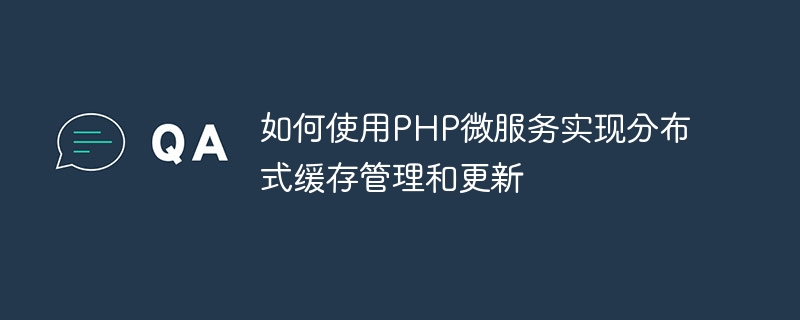Home >Backend Development >PHP Tutorial >How to use PHP microservices to implement distributed cache management and updates
How to use PHP microservices to implement distributed cache management and updates
- WBOYWBOYWBOYWBOYWBOYWBOYWBOYWBOYWBOYWBOYWBOYWBOYWBOriginal
- 2023-09-25 10:51:211512browse

How to use PHP microservices to implement distributed cache management and update
Introduction:
In modern distributed systems, caching is an important technology , which can improve the performance and scalability of the system. As a popular back-end programming language, PHP also has many excellent frameworks and tools that can help us achieve distributed cache management and updates. This article will introduce how to use PHP microservices to implement distributed cache management and updates, and provide specific code examples.
1. Overview of Microservice Architecture
Microservice architecture is an architectural style that splits the system into multiple independent, independently deployable services. Each microservice has its own data storage and business logic and can communicate through APIs. In the scenario of distributed cache management and update, the cache can be implemented as an independent microservice. This can decouple the cache service from other services and improve the maintainability and scalability of the system.
2. Use Redis as distributed cache storage
Redis is a high-performance key-value storage system that provides a rich set of data structures and operation commands and is very suitable for use as distributed cache storage. Redis can be operated in PHP through the Redis extension or Predis library. The following is a sample code that uses the Predis library to connect and operate Redis:
<?php
require 'vendor/autoload.php';
$client = new PredisClient([
'scheme' => 'tcp',
'host' => 'cache_server',
'port' => 6379,
]);
// 设置缓存
$client->set('key', 'value');
// 获取缓存
$value = $client->get('key');
// 删除缓存
$client->del('key');
?>3. Implement distributed cache management and update
In a distributed system, cache consistency is an important issue. When the data in the system is updated, it is necessary to ensure that the data in the cache can be updated in time. The following is a sample code that uses message queues to implement distributed cache updates:
Cache service:
<?php
require 'vendor/autoload.php';
$cacheClient = new PredisClient(/* Redis配置 */);
$messageQueue = new PredisClient(/* Redis配置 */);
$cacheClient->subscribe(['cache_update'], function ($message, $channel) use ($cacheClient) {
$data = json_decode($message, true);
// 更新缓存
$cacheClient->set($data['key'], $data['value']);
}, 'cache_update');
while (true) {
$messageQueue->publish('cache_update', json_encode(['key' => 'key', 'value' => 'value']));
sleep(60);
}
?>Data update service:
<?php
require 'vendor/autoload.php';
$messageQueue = new PredisClient(/* Redis配置 */);
// 数据更新操作
// ...
// 发布消息,通知缓存服务更新缓存
$messageQueue->publish('cache_update', json_encode(['key' => 'key', 'value' => 'value']));
?>In the above sample code, the cache service Subscribed to the cache_update channel and updated the cache after receiving messages. After performing the data update operation, the data update service notifies the cache service to update the cache by publishing a message.
Conclusion:
Distributed cache management and updates can be easily implemented using PHP microservices. By treating the cache as an independent microservice, system decoupling and scalability can be achieved. At the same time, using Redis as a distributed cache storage can provide high performance and rich operation commands. When using message queues to implement cache updates, the consistency of cached data can be guaranteed. We hope that the code examples in this article can help readers implement distributed cache management and updates in practice.
The above is the detailed content of How to use PHP microservices to implement distributed cache management and updates. For more information, please follow other related articles on the PHP Chinese website!

